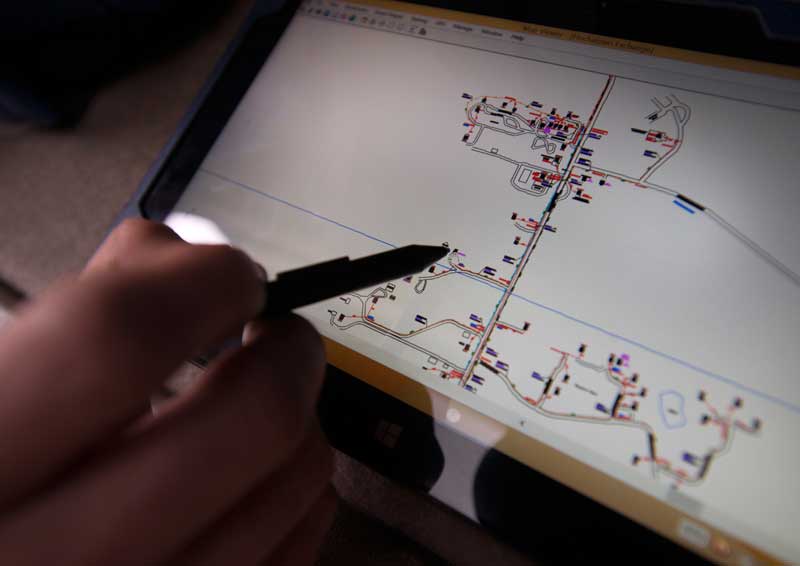Digital communications and infrastructure dependencies
Contents |
[edit] Introduction
The UK currently has one of the most advanced digital communication infrastructure systems in Europe. Considerable investment made early on has driven the UK’s strong e-commerce position. And recent UK policy developments – investment in 5G research and development, superfast broadband deployment, the recently launched Digital Strategy – indicate that the government is keen to build on this position and enable better connectivity for people and businesses.
This increasingly ubiquitous digital connectivity cannot be looked at without considering the technological changes this enables and the impacts on the existing physical infrastructure.
The increasing pervasiveness of digital and ‘smart’ technology, enabling collection and analysis of big data, is to have a profound impact on infrastructure needs, demands and delivery across all sectors – and is only likely to increase with future innovation.
5G technology has the potential to realise or enable a number of high-value use-cases, including autonomous vehicles, Internet of Things, smart cities, and real-time infrastructure operational data. However, consideration should be given to the impacts on other exiting infrastructure, like transport systems and particularly electricity generation.
[edit] 5G ambitions
Precisely what 5G is, and what it will do versus existing generations of connectivity, is as yet undefined.
Currently, it is anticipated that 5G technology will mean seamless connectivity, ultra-fast and ultra-reliable, transmitting massive amounts of data with virtually no lag. By 2050, it is expected that the main access points to data services will be through mobile devices and the internet of things based on widespread coverage of 5G, or other mobile broadband.
To date, there has been strong political ambition for the UK to be a world leader in 5G technology deployment, reflected in Ofcom Strategic Review of Digital Communications 2016 and the NIC Connected Future report.
However, the desire for expediency in delivery must be balanced with the need to ensure implementation of a system that can meet long-term economic, social and environmental needs. As with existing digital connectivity efforts must be made to ensure comprehensive coverage. This will require increased densification of supporting infrastructure, and changes to planning frameworks should be made with this in mind.
[edit] Infrastructure interdependencies
The ICE-led National Needs Assessment (NNA) highlighted the importance of considering infrastructure interdependencies between sectors as part of the NIA, and as infrastructure becomes increasingly ‘smart’ it can be expected that these interdependencies will deepen.
For example, digitally enabled infrastructure, ‘always on’ connectivity, and the rise of big data have considerable electricity generation and transmission implications.
The National Resource Defence Council reports that in 2013 US data centres consumed energy equivalent to 34 500MW coal fired power stations, managing the storage and sharing of the huge quantities of data requires policy action if data demand and ultimately energy to support are not to grow beyond sustainable levels.
This places considerable pressure upon existing generation and transmission infrastructure, particularly in the context of the growing electrification of transport and heat. However, smart electricity infrastructure can help to balance demand with new electricity generation coming onto the grid, enabling integration of renewables and electricity storage.
This article was originally published here by ICE on 13 March 2017. It was written by Kelly Forbes, ICE Policy Manager.
--The Institution of Civil Engineers
[edit] Related articles on Designing Buildings Wiki
- Achieving sustainable roads funding in England.
- Articles by ICE on Designing Buildings Wiki.
- Critical infrastructure is more vulnerable than ever. It doesn’t have to be that way.
- Designing smart cities.
- Digital Connectivity Infrastructure Accelerator DCIA.
- Digital transformation - engineers need to keep pace.
- Digital transformation - overcoming barriers.
- Electrotechnical industry gears up for All-IP switch.
- Engineering resilience to human threats.
- Email overload.
- Future skills for civil engineers.
- Infrastructure and cyber attacks.
- Intelligent building management systems IBMS.
- Internet of things.
- Smart buildings.
- State of the nation: Digital transformation.
- UK BIM Alliance and CIOB join forces.
- Vital infrastructure and redevelopment.
- WiFi.
Featured articles and news
The UK’s largest air pollution campaign.
Future Homes Standard, now includes solar, but what else?
Will the new standard, due to in the Autumn, go far enough in terms of performance ?
BSRIA Briefing: Cleaner Air, Better tomorrow
A look back at issues relating to inside and outside air quality, discussed during the BSRIA briefing in 2023.
Restoring Abbotsford's hothouse
Bringing the writer Walter Scott's garden to life.
Reflections on the spending review with CIAT.
Retired firefighter cycles world to raise Grenfell funds
Leaving on 14 June 2025 Stephen will raise money for youth and schools through the Grenfell Foundation.
Key points for construction at a glance with industry reactions.
Functionality, visibility and sustainability
The simpler approach to specification.
Architects, architecture, buildings, and inspiration in film
The close ties between makers and the movies, with our long list of suggested viewing.
SELECT three-point plan for action issued to MSPs
Call for Scottish regulation, green skills and recognition of electrotechnical industry as part of a manifesto for Scottish Parliamentary elections.
UCEM becomes the University of the Built Environment
Major milestone in its 106-year history, follows recent merger with London School of Architecture (LSE).
Professional practical experience for Architects in training
The long process to transform the nature of education and professional practical experience in the Architecture profession following recent reports.
A people-first approach to retrofit
Moving away from the destructive paradigm of fabric-first.
International Electrician Day, 10 June 2025
Celebrating the role of electrical engineers from André-Marie Amperè, today and for the future.
New guide for clients launched at Houses of Parliament
'There has never been a more important time for clients to step up and ...ask the right questions'
The impact of recycled slate tiles
Innovation across the decades.
EPC changes for existing buildings
Changes and their context as the new RdSAP methodology comes into use from 15 June.

























